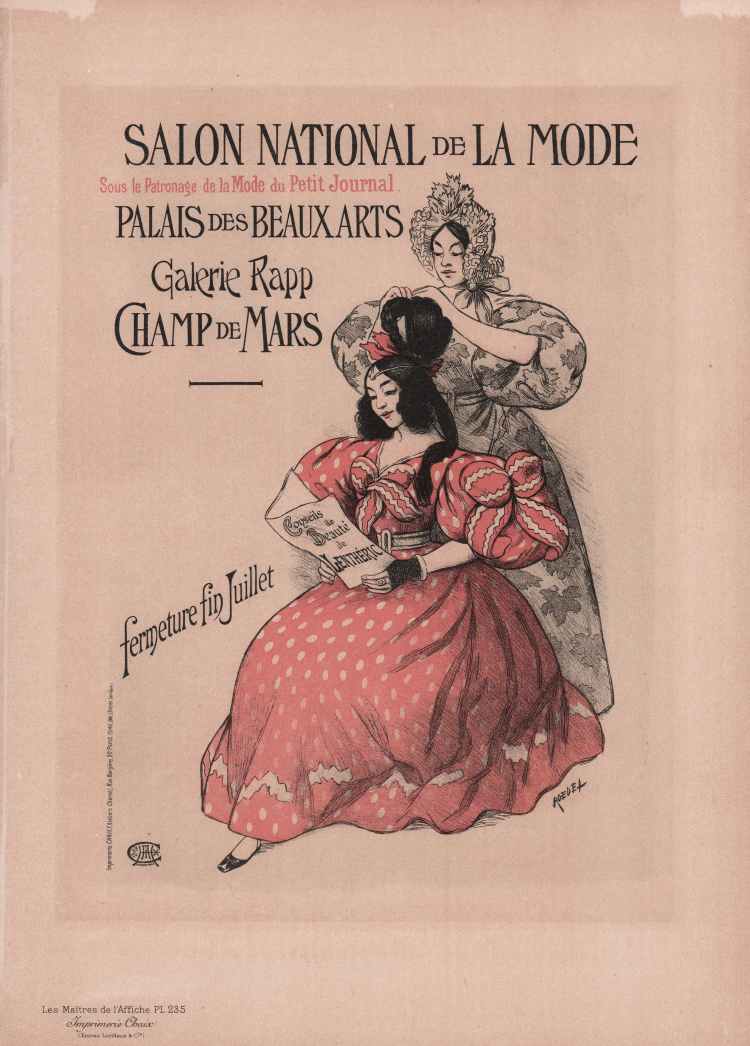



| Reference: | S1686 |
| Author | Auguste Roedel |
| Year: | 1900 |
| Measures: | 290 x 395 mm |


| Reference: | S1686 |
| Author | Auguste Roedel |
| Year: | 1900 |
| Measures: | 290 x 395 mm |
Lithograph printed in color on tissue paper, in very good condition. Table n° 235 of the fifth annual volume (1900) of Les Maîtres de l'affiche.
Composition created for the 1896 fashion show by Auguste Roedel.
Proof with the embossed stamp of Les Maîtres de l'affiche in the lower right corner (Lugt: L.1777c), signed in the plate, printed at Chaix (Ateliers Chéret) rue Bergère in Paris.
Les Maîtres de l'affiche is a monthly French publication printed in France between December 1895 and November 1900. The idea to create the magazine is of Jules Chéret, at the time artistic director of Chaix, a printing house located in Paris at 20 rue Bergère. Each issue includes four posters reproduced using the technique of chromolithography. Each copy had an embossed stamp of authentication. The sale price was 2.50 francs per issue, while a subscription cost 27 francs. There was also a luxury edition on Japan printed in 100 copies and sold for 80 francs for 12 issues.
In January 1897, a first volume was put on sale that included all the affiches published the previous year; the publication had a preface signed by Roger Marx and had a format created by Jean Engel based on a project by Paul Berthon. Until January 1901, the date of the magazine's closure, a total of five volumes were produced, with 97 artists involved.
The 256 color plates that make up the suite represent a wide-ranging selection of outstanding original posters from the turn of the twentieth century when this popular art form first reached its peak.
Early printed posters were very text-heavy, with relatively few illustrations. After all, they were created to advertise products, and adding an illustration to an advertisement in the mid-1800s was not commonplace. However, during the second half of the nineteenth century, when all types of commercial products were aesthetically upgraded, serious artists began to see the new possibilities in the poster medium. By linking their imagery to modern commerce, the thinking was that each would be enhanced by the value of the other. This was especially true for Jules Cheret (1836-1932) whose unique combination of artistic, technical, and entrepreneurial talents paved the way for an actual poster industry. Cheret opened his own print shop in Paris in 1866 – Imprimerie Chaix – and his work then began to inspire numerous emulators throughout Europe and America.
By the 1890s the streets of every great city were enlivened by large, colorful posters. The posters had not only caught the fancy of the public, but its best examples were already being regarded as true works of art (specifically, as fine prints) to be exhibited, reviewed in journals, and collected and reproduced in a more manageable form. In the last five years of the century, the ebullient spirit of the “Belle Epoque,” gave birth to a new artistic movement. It was during those years that Imprimerie Chaix was to play a significant part in codifying, hallowing, and perpetuating Cheret’s vision through printmaking.
Auguste Roedel (La Chapelle 1859 - Parigi 1900)
|
Auguste Roedel was born in the commune of La Chapelle, a few months before it became part of Paris (law of June 16, 1859). During the 1880s he began drawing and frequenting cabarets and dances, especially in the neighborhoods around Butte Montmartre and Place Pigalle. He produced cartoons for newspapers such as Le Petit Illustré, l'Almanach du Père Peinard or even, later, Le Courrier français or L'Estampe moderne. He also illustrates piano scores. Roedel met Jules Chéret shortly before 1890 and began producing posters for the Imprimerie Chaix, including Linge Monopole Maxime Faivret which, unlike La Chérette, promoted a plumper woman: having become an essential artist of the Butte, Roedel declined this figure for nearly ten years. During this period, his production was intense, he worked for Parisian printers such as Imprimerie d'Art E. Malfeyt, Eugène Mauler, Sicard and Farradesche, Courmont frères or Chaimbaud. Chéret reproduced four of Roedel's creations in his magazine Les Maîtres de l'Affiche (1895-1900), namely: Moulin de la Galette, La Vache enragée, Linge Monopole Maxime Faivret and Salon de la Mode.
|
Auguste Roedel (La Chapelle 1859 - Parigi 1900)
|
Auguste Roedel was born in the commune of La Chapelle, a few months before it became part of Paris (law of June 16, 1859). During the 1880s he began drawing and frequenting cabarets and dances, especially in the neighborhoods around Butte Montmartre and Place Pigalle. He produced cartoons for newspapers such as Le Petit Illustré, l'Almanach du Père Peinard or even, later, Le Courrier français or L'Estampe moderne. He also illustrates piano scores. Roedel met Jules Chéret shortly before 1890 and began producing posters for the Imprimerie Chaix, including Linge Monopole Maxime Faivret which, unlike La Chérette, promoted a plumper woman: having become an essential artist of the Butte, Roedel declined this figure for nearly ten years. During this period, his production was intense, he worked for Parisian printers such as Imprimerie d'Art E. Malfeyt, Eugène Mauler, Sicard and Farradesche, Courmont frères or Chaimbaud. Chéret reproduced four of Roedel's creations in his magazine Les Maîtres de l'Affiche (1895-1900), namely: Moulin de la Galette, La Vache enragée, Linge Monopole Maxime Faivret and Salon de la Mode.
|